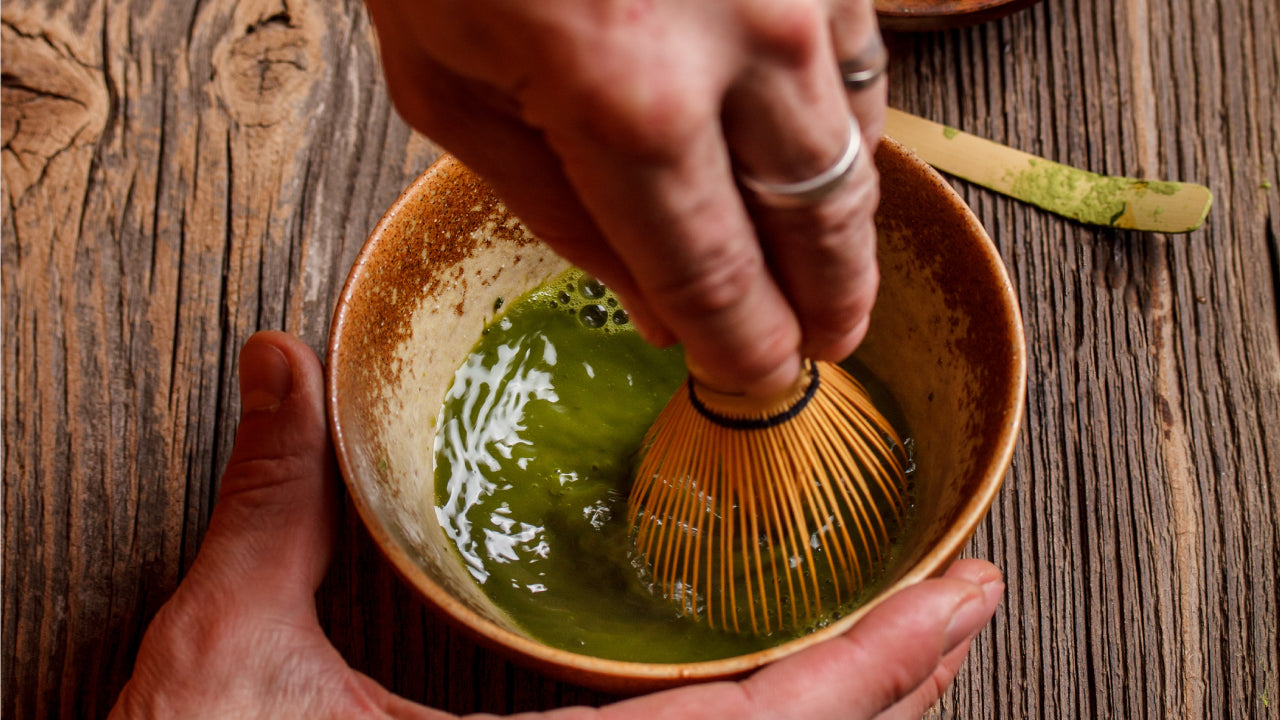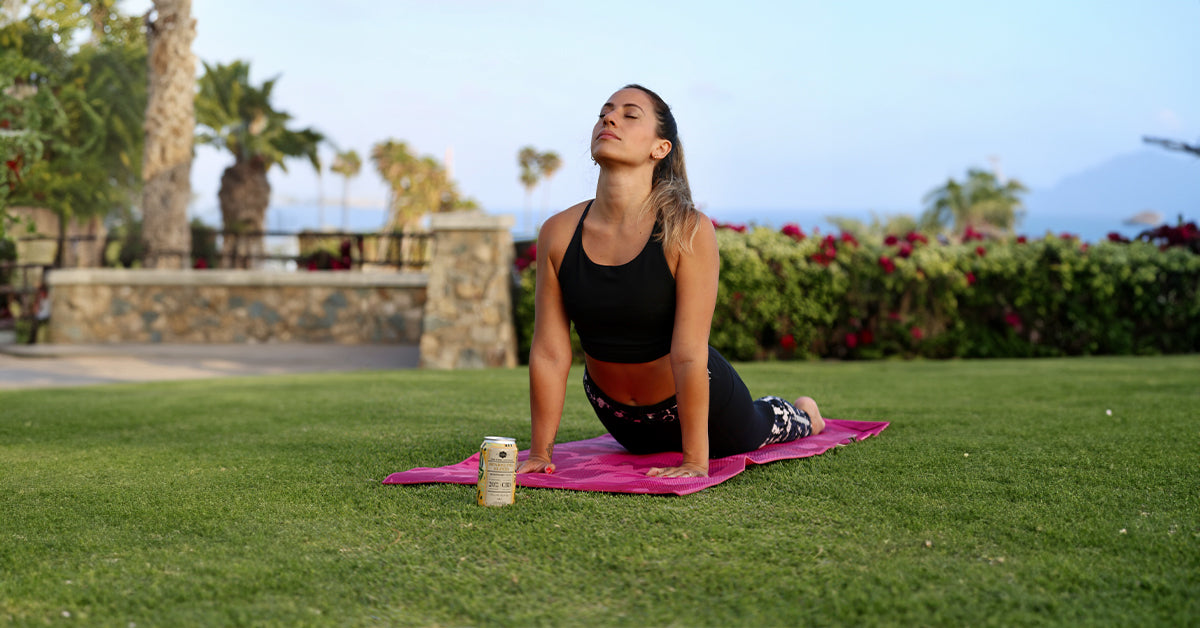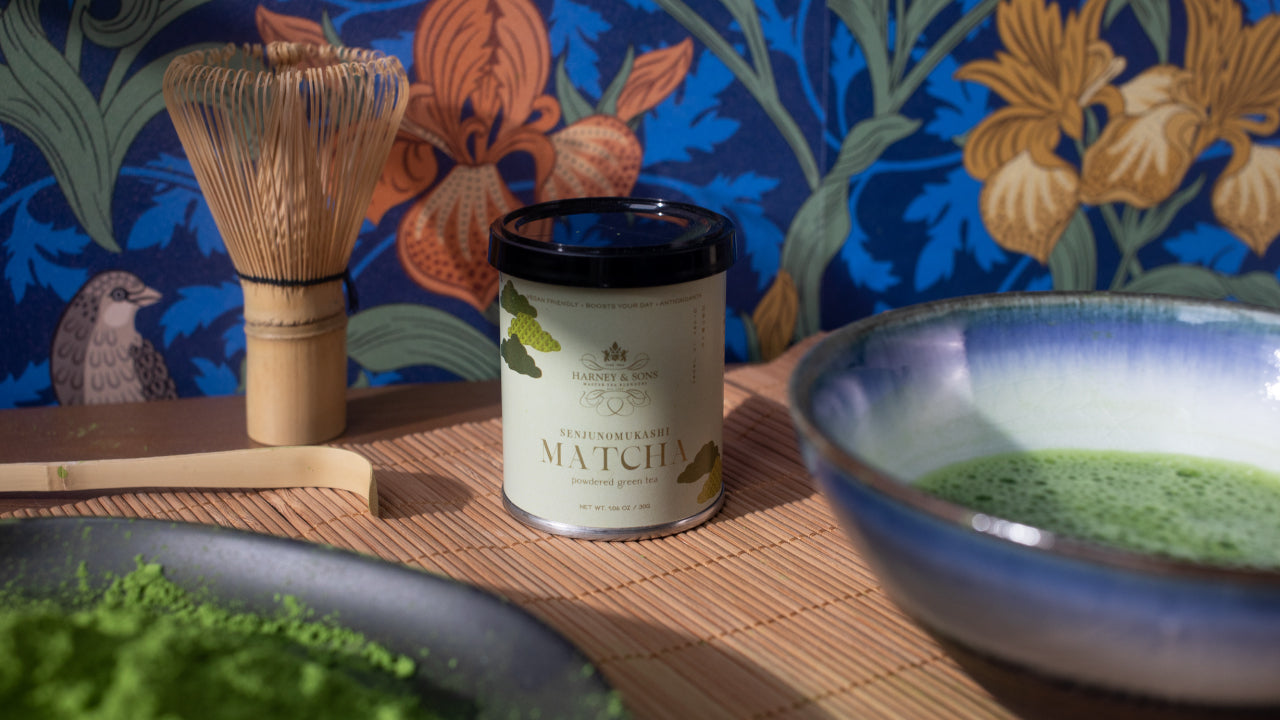Matcha has become a real phenomenon in the US. So much is being drunk and bought from Japan that it is reshaping the Japanese tea business. Fields are being converted. People understand the health benefits and are drinking more and more matcha. There are matcha bars in several cities. Crazy!
Since matcha has now taken its place in the global teascape, I thought it might be helpful to better understand this sometimes under-appreciated but wonderful powdered green tea. So, let’s dive in!

What Is Matcha?
Matcha can come from many different tea plants. Traditionally, it comes from Japan, but there are Chinese versions nowadays.
As the tea plant grows in the spring, the growers slowly cover it over. The plant reacts by making more green chlorophyll and develops special chemicals to try and adjust. Eventually, the plant is almost completely shaded. Then they are harvested; in the better matcha grades, it is hand harvested. Next the tea leaves are dried in air tunnels (sort of like those fake parachute tunnels). Later the dried tea leaves (tencha) are ground up.
The Japanese use many tea plant varieties: asahi, saimidori, and yabukita to mention a few. We get our matcha from ground tencha leaves from around the Uji area, which is close to the old imperial capital of Kyoto. While not many people drink tencha that isn’t powdered, Harney & Sons is one of the few that offer it. It is an unusual green tea because it is only air dried, which makes for a light vegetal flavored brew.
When it comes to matcha’s origin story … the mists of history make the origins a bit foggy. However, it seems that the Chinese would make a cake of compressed green tea, then pulverize it and blend it with hot water. The Japanese refined the process. It became the basis for the Japanese Tea Ceremony (the Way of Tea or Chado).

What Are the Different Types of Matcha, and What Can You Do With Them?
Harney & Sons offers several grades of matcha. The different grades depend upon the season, growing location, and production method.
The best matcha is defined as one that has lots of umami. “Umami” means “essence of deliciousness” in Japanese. Who would not want that? The source of that umami comes from high levels of the amino acid l-theanine – that’s what creates a mouth-filling and slightly sweet brew. Shade-grown teas (matcha, tencha, and gyokuro) have more than twice the amount of amino acids as regular sencha.
Another quality definition is the color of the leaves and the brew – the darker the leaves, the higher the quality. Also, when farmers cover the leaves, they develop a special aroma. That aroma, which used to be called ‘rice straw’ aroma, is actually a derivative of sulfur and smells similar to asparagus. Shade-grown matcha has more than 10 times that wonderful aroma. The best grade we offer (Unjonotomo) has twice as much of the lovely aroma as the Everyday Organic Matcha.
Now you know the qualities of the best shade-grown matcha. The very best comes from Uji itself. The source of Unjonotomo is a small garden along the Uji River. It is harvested in early May. The Jobetsugi is grown about 45 minutes away in the Wazuka Valley and is produced at about the same time. The teas that are made in the small tins (Unjonotomo, Senjunomukashi, Jobetsugi, and Organic Matcha) are made in the traditional way of small stone mills.
The Everyday Organic is made in the summer and is from the southern island of Kyushu. That makes for a lighter green and a thinner matcha. The Everyday Organic is made in a larger, more industrial mill. This makes for a lighter and less expensive brew, one that can be used in the kitchen and the bar.
Speaking of which…you can use matcha in a variety of ways. We would recommend the Everyday Organic Matcha, since it is less expensive and can be purchased in a one-pound bag. It can be blended into cakes, sprinkled on salmon, and made into a tasty green sauce with yogurt. You can even do something unusual and make it into a latte, like this Strawberry Iced Matcha Latte, perfect for spring’s very welcome warmer temps.

Some Common Matcha Questions
There are some questions we routinely get about matcha that I’m happy to answer here.
1. What is the difference between your Organic Matcha and Everyday Organic Matcha?
Both are made in the southern island of Kyushu. The small tin (Organic Matcha) is made in the spring from the best young teas. The Everyday Organic Matcha is made later in the spring, making it more economical. This can be used for baking and beverages. It is better than the average matcha sold as “Culinary.”
Please note that one of the most endearing qualities of matcha is the mouth-filling umami flavors. If the tea grower is using just organic fertilizers on the tea plants, there is less nitrogen for the plant, thus less amino acids. So Certified Organic matchas have less umami or body than our other ones.
2. What is ceremonial matcha?
This would be a matcha that would be suitable for the Japanese Tea Ceremony. The idea is that tea has so much great flavor and umami that you can use less water and make a special brew, concentrated with all the great flavors. That is why it is also called Thick Tea. Nowadays, the term Ceremonial has gotten very diluted, so we avoid using it. We would recommend our Unjonotomo or Senjunomukashi for the Japanese Tea Ceremony. They have great umami and those lovely slightly sulfur aroma notes.
3. Does matcha have the same benefits as green tea?
Since one drinks the actual leaves when drinking matcha rather than a brew strained from the leaves, the antioxidant level is higher, and so are the amino acid levels. These perceived health benefits are what make matcha so popular.
4. How would you describe how matcha tastes?
It is mouth-filling and slightly sweet. The aroma and taste are vegetal, edging toward asparagus and kelp. Depending on which one you are enjoying, their flavors will be more or less intense.
5. For someone who is new to matcha, what kind would you suggest they drink, and how should they prepare it?
I would start with our Jobetsugi and make it the way we recommend in this video:
Later, you can explore the higher quality matchas. Some might want to give our flavored matchas a try. We offer Very Berry Matcha, White Peach Matcha, and our newest flavor, Earl Grey Matcha. There’s also a refreshing White Peach Matcha bottled iced tea for a great summer beverage.
We created these flavored matchas because we know there are some people who do not like the vegetal flavors, so we decided to add natural flavors to green tea and blend in matcha. Earl Grey is our #3 best-selling flavor, so that was a no-brainer. We did a bit of a contest for the other two flavors. White Peach and Very Berry won, and they are delicious.
6. What do you say to people who don’t like the flavor of matcha?
They have two ways to proceed. They can keep drinking matcha and see if they get to like the flavor. Or they can use one of the three flavored matchas. I would love for them to keep trying.
7. What’s your favorite matcha?
I like the Unjonotomo the best. But as we say around these parts, always drink teas that make you smile! So whatever matcha suits you, that’s the matcha you should drink. Cheers!















